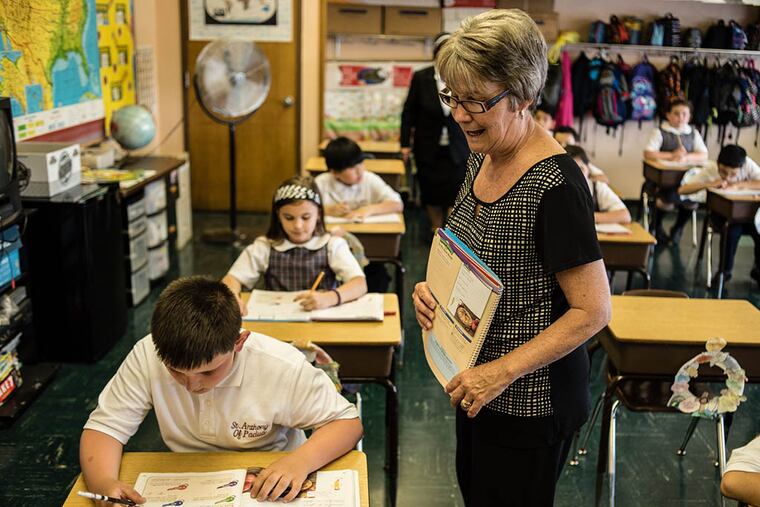Curses! Whatever happened to cursive writing?
Teaching it is mandatory in the areas parochial schools, but Philly has eased it out of the curriculum as the world has gone digital.

PATRICIA LAFFERTY has some rules for pupils learning cursive writing in her class.
"Proper posture for proper penmanship," Lafferty told her third-graders yesterday at St. Anthony of Padua Regional Catholic School in South Philadelphia. "Put your feet under your desk, not under your chairs."
They were learning to write a proper cursive "n" in their handbooks. Each page had a sample cursive letter and an area to practice it, with three lines to help guide their writing.
The boys and girls watched Lafferty write a lowercase "n" on the chalkboard, which also had the three lines. Two bumps should hit the middle line - not three, or it would be an "m," she told them.
Such a lesson is commonplace in every parochial school in the city - but rare in Philadelphia public schools, where Common Core State Standards established in 2011 don't include cursive as a requirement. The standards require students to be able to convey information in writing - print, cursive or type.
Even before states began to adopt those standards, public schools had been excising the subject from curricula as the world has become increasingly digital.
"Cursive writing is an optional subject in our schools," said school district spokesman Fernando Gallard. Teachers can instruct cursive writing between third and fourth grades, but it's up to them, he said.
Gallard declined to say why the district altered its curriculum to make cursive an optional subject. "The change was made many years ago," he said. "I don't know when and why that change was made, but it's been at least 10 years."
Philadelphia isn't the only large urban area on the East Coast whose public schools no longer require cursive-writing instruction:
* Boston stopped teaching cursive five years ago.
* Washington, D.C., pupils were taught cursive - they had to write legibly by the third grade - until 2011.
* New York City schools stopped mandating cursive instruction a long time ago, and in the mid-1990s it was no longer included in New York state standards.
But some states may be close to turning back the clock to a time when cursive was standard.
An Ohio state representative introduced a bill earlier this year mandating handwriting, including cursive, from kindergarten to fifth grade. Tennessee lawmakers passed legislation in 2014 that would make cursive mandatory from second to fourth grades starting this fall.
Advocates for the cursive tradition argue that it should continue to be taught so that children can sign their names to legal documents, read historical documents in their original form and carry on a tradition that's as old as time.
They point to studies that found that children who write cursive learn to think better and have an advantage when it comes to composition and reading. Catholic-school officials say those pupils have stronger focus and retain information better.
"Researchers are telling us that it helps develop cognitive skills, more so than texting," said Sister Edward William Quinn, director of elementary curriculum and instruction for the Archdiocese of Philadelphia.
When students use cursive, they "need to think more about their writing," Quinn added.
Pupils retain more information with cursive writing because "they spend more time on it, and that little bit of time helps," she said.
Virginia Berninger, a Northeast Philadelphia native who is now a psychologist on the faculty at the University of Washington in Seattle, was part of a team that did a five-year study on children in fourth through seventh grades. The study, released this year, found that children who wrote cursive "did better on spelling and composing tasks," she said.
The act of connecting letters in cursive was key to that improvement, Berninger said.
"The connection of strokes helps link component letters into a word unit," she said. "That makes it easier to find words in memory, which helps in composing and spelling."
Those who argue against cursive writing say that young people today are surrounded by print writing and have no need for cursive - and that a thumbprint can stand in for a cursive signature.
Weston Kincade, a teacher at Akron Digital Academy in Ohio, a hybrid high school that combines brick-and-mortar classrooms with an online curriculum, published an online essay titled "Heyday of Cursive Writing is Over."
"Cursive seems to be dying out," Kincade said. He personally uses cursive "almost constantly" in his writing, he added.
But "I have to use print in the classroom. Print is what has been used for teaching for generations," Kincade said.
The skills that students learn from cursive writing are important, Kincade said, but those skills can be learned through other activities.
Kincade applauded Ohio state Rep. Cheryl Grossman's efforts to make cursive mandatory.
"My bigger concern is: Where will you find the time to teach it?" he said.
Online: ph.ly/DNEducation